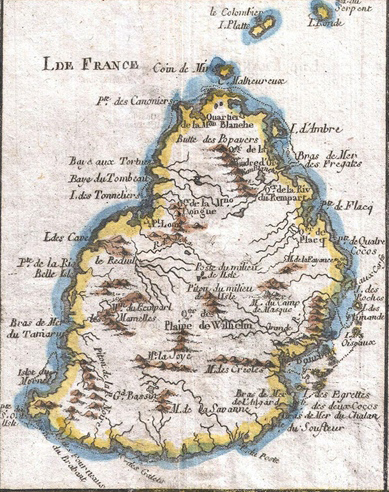

Once upon a time, a volcanic eruption gave birth to a tiny island right in the middle of the Indian Ocean.
At the beginning, this piece of land now known as Mauritius and Rodrigues, a smaller island within the Mauritian territory, didn’t seem to interest anybody.
Their only inhabitants, endemic bird species like the Dodo(Raphus cucullatus) in Mauritius and the Solitaire (Pezophaps solitaria) in Rodrigues and extinct giant tortoises (Cylindraspis triserrata) lived in harmony amidst the majestic Black Ebony (Diopyros tessellaria), endemic to Mauritius and commonly known as the Mauritian Ebony.
They led a peaceful life until navigators started exploring the oceans in search of new lands to conquer, new exotic products to exploit and new territories to extend their Empire.
Mauritius gradually became a strategic halt on the Spice Route. In the early VIIIth century, the Arabs dominated the Indian Ocean after reaching China. But Mauritius didn’t interest them. They contented themselves by giving a name to the island, Dina Robin.
The European maritime epic started during the Renaissance period. The Portuguese were the first to cross the Cape of Good Hope before reaching India. Vasco de Gama turned Calicut, on the Malabar Coast, into the first commercial base from which they would extend their supremacy.
The Indian Ocean was transformed due to commercial exchanges. Ships laden with silk, precious spices like cardamom, pepper, ginger, cinnamon, and specially clove and nutmeg, took this route which linked the East to the West.
It was the dawn of a new era which changed the commercial and geopolitical profile of this part of the world.
In this unquenchable thirst of power and wealth, the island was more and coveted and visited.
For the Portuguese, Mauritius was a mere halt. They landed on the island at the beginning of the XVIth century and named it Cirné.
That’s the name that appears on the maps when the Dutch landed on the island in a hazardous, thrown on the shores of the island by a storm, in 1598.
In this spice race, they decided to make the most of the commercial advantages the island offered.
Cirné became Mauritius.
In 1638, the Dutch tried to establish a colony. But in vain. Frequent cyclones destroyed their installations and harvests. They left the island definitely in 1710.
The French who were already implanted in Pondicherry since 1974 and Chandernagor since 1690, immediately took advantage of this situation to consolidate their position in the region.
In 1715, they take hold of the island in the name of Louis XIV and change its name into Isle de France.
The French colonisation period begins in 1722. But it’s under governor Mahé de La Bourdonnais that it really took off. He proposed to transform the island firstly, into a naval base for France, and secondly into a warehouse for its commercial activities with India.
Isle de France flourished and became a major stop for travellers, explorers and scientific expeditions. The island becomes sees the legendary love story between Paul and Virginie bloom.
But, France starts neglecting the island at the beginning of the XIXth century as Napoleonian battles capture all attention. The colony’s survival depended only on French corsairs who keep nagging British vessels in the Indian Ocean. The king of corsairs, Surcouf, turns Port Louis, the capital of Mauritius, his main port and keeps up the spirit of the representatives of the French king through his naval victories.
England wanted Mauritius as the politician Lord Chatham stated, the “British will never be the masters of India, until the French will have Isle de France”.
As a treasure island, a land of adventure and an indispensable halt on the Spice Route and maritime commercial links, the Star and the Key of the Indian Ocean (Stella Clavisque Maris Indici) The Coats of Arm of Mauritius are stipulated in the, has been visited by explorers, sailors, botanists, scientists, writers and occupied by conquerors.
Discovered, visited, colonised, abandoned, defended, liberated, Mauritius has witnessed several periods of colonisation and waves of immigration which have shaped its history and forged its population and culture.
